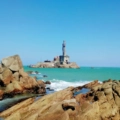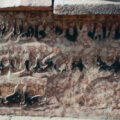There is no denying the fact that Goa has a very laid-back vibe. A Goan sojourn, by design, is inevitably about the sun, sand and the sea with generous quantities of food, cheap alcohol, and merry-making. But if you look further, it isn’t hard to uncover some of Goa’s hidden gems.
With a remarkably long history dating back to the mythological era, the remnants of the changing times are clearly visible in the daily lives of Goans.

From the morning wakeup call of the poi sellers to watching the sunset from the ruins of an ancient fort, some experiences keep you engaged throughout the day. You, therefore, don’t have to depend on Goa’s beaches to give you the perfect holiday.
If you’d like to shun the cliché on your next Goan getaway and experience a side that takes you closer to its heart, read on.

Meal at a 200-year-old Portuguese Mansion
Sitting pretty, across a church by the bend of the Kushavati river, is Palácio do Deão. A 200-year-old estate of a nobleman who was also the Dean of the church, it uniquely blends the traditional Goan and Portuguese architecture.
Spread across two acres of tropical landscape peppered with laterite figurines, the terraced gardens lead you to a chappel at the entrance of the mansion.
The current owners have painstakingly restored the mansion and turned a part of it into a small museum displaying artefacts of its colonial past. End your tour in the balcony of the residence and enjoy a sit-down lunch of traditional Goan-Portuguese fare.
Located in Quepem (South Goa), a visit here will cover a good part of your day. But the scenery along the way through lush green countryside makes up for the long drive here from the trendier North.
Location: Opposite Holy Cross, Quepem, Goa 403705

Art Attack
Located amidst an industrial set up, Museum of Goa (MOG – meaning ‘love’ in Konkani), is one of the largest contemporary art spaces in India.
Established in 2015, it is the fruit of the efforts put in by the founder and artist Subodh Kerkar who has brought this three-story structure to life.
It is a heaven for contemporary art lovers, as it houses works that break social barriers, of both Indian and International artists. The art here is an eclectic mix of installations, sculptures, paintings, photos, and videos.
One of the most striking though is the row of torsos which, adorned with both rosaries and jhanvem (sacred thread worn by the Brahmins). Each torso is given a name that is a blend of Christian – Brahmin cultures, symbolising the history of conversion and caste tiers in the state.
The art showcased here is a unique blend of mythology and Goan history combined with contemporary art. It also has an on-site organic café and a museum shop where you can unwind and buy souvenirs at the end of your visit to the museum.
Location: 79, Pilerne Industrial Estate, Pilerne, Bardez, Goa, 403511
Visit the Oldest Fort-like Structure in Goa
In service from 1493 until 1993, the Reis Magos Fort (Portuguese for Three Wise Men), was built in stages at the mouth of the Mandovi river.
It served as a defence outpost initially, then a residence for the Viceroys, a jail and a hospital during its lifetime.
The Portuguese built the actual structure that we see today, in 1551. Sadly, it was abandoned after 1993 and fell into decay.
Later, restoration started on this falling historic site with funds from the Helen Hamlyn Trust and under the guidance of INTACH, making it accessible to visitors, once again. Today a few of the original guns and a breathtaking view of the sea remain.
Rising above the waters of the Mandovi, it has transformed into a must-visit cultural and heritage centre. It has various galleries that display the 450-year history of Goa and its liberation, through photographs. The art gallery here also houses works of various Goan artists, most famous among them being Mario Miranda.
Location: Verem, Bardez, Goa – India. 403 114

A Walk-Through History
In the bustling capital city of Panjim, there lies a little corner that resembles a sleepy town in Portugal. Established in the late 18th century by a wealthy merchant named Antonio Joao de Sequeira, it is today a conglomeration of colourful colonial architecture, popularly known locally as the Fontainhas.
A stroll through its tiny lanes leads you past old Portuguese houses painted in pastel colours with red-tiled roofs. You encounter tiny cafes and bakeries, some over 100 years old, and streets with distinct names that are a visual reminder of its colonial past.
A formal guided tour can be booked, that take you through this heritage area while sharing bits of its history that has survived the onslaught of modernisation. Also giving a chance to visit some of the houses from the inside.
Location: Fontainhas, Panjim

The Backwaters of Goa
While many know of the salty waters along Goa’s shores, very few know of the mangroves that make up the interiors of the state. These not only hold the soil steady but are a biodiversity hotspot.
The best way to experience these is on a kayaking adventure through some untouched backwaters, listening to the sound of the birds and slowly gliding with the river current.
If you prefer not to do the hard work of paddling, then the crocodile spotting tour through the Cumbarjua Canal is the trip for you. An experience far removed from the crowd, this boat tour takes you through the canal connecting the Mandovi and Zuari rivers, the waters of which are home to Marsh Muggars.

So, the next time you are in the region, take a day off from lounging on the beach, and head on out to discover some of the most fascinating and unknown attractions of Goa that will genuinely captivate your senses with unmatched adventure and beauty.
Photos: Author, Unsplash and Pixabay






6 Comments
usfman
My wife and I will be taking a 16 day spiritual tour of the southeast region of India in February. I would welcome any blog info.from you about some of the cities we will visit.
usfman
Here is our tour.
14 nights accommodations
2 nights Chennai
2 nights Mahabalipuram
1 night Pondicherry
2 nights Thanjavur
2 nights Madurai
2 nights Periyar National Park
3 nights Kochi